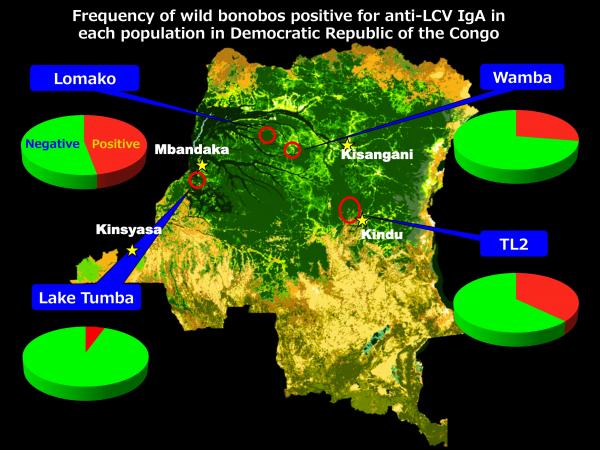



|
TOPICS BONOBO Chimpanzee "Ai" Crania photos Itani Jun'ichiro archives Open datasets for behavioral analysis Guidelines for Care and Use of Nonhuman Primates(pdf) Study material catalogue/database Guideline for field research of non-human primates 2019(pdf) Primate Genome DB 
Primate Research Institute, Kyoto University Copyright (c) |
Japanese Epidemiological surveillance of lymphocryptovirus infection in wild bonobos
Tomoyuki Yoshida, Hiroyuki Takemoto, Tetsuya Sakamaki, Nahoko Tokuyama, John Hart, Terese Hart, Jef Dupain, Amy Cobden, Mbangi Mulavwa, Yoshi Kawamoto, Akihisa Kaneko, Yuki Enomoto, Eiji Sato, Takanori Kooriyama, Takako Miyabe-Nishiwaki, Juri Suzuki, Akatsuki Saito, Munehiro Okamoto, Masaki Tomonaga, Tetsuro Matsuzawa, Takeshi Furuichi and Hirofumi Akari
Abstract
Lymphocryptovirus (LCV) is one of the major gena in the herpesvirus family and is widely disseminated among primates. LCVs of human and rhesus macaques are shown to be causative agents of a number of malignant diseases including lymphoma and carcinoma. Bonobos (Pan paniscus) are highly endangered and the least studied species of the great apes. Considering the potential pathogenicity of the LCV that might threaten the fate of wild bonobos, population-based epidemiological information in terms of LCV prevalence in different location of Bonobo„ŗ—‘ habitats will help propose improved conservation strategies for the bonobos. However, such data are not available yet because it is very difficult to collect blood samples in the wild and thus virtually impossible to conduct sero-epidemiological study on the wild ape. In order to overcome this issue, we focused on evaluating anti-LCV IgA in the feces of bonobos, which are available in a noninvasive manner. Preliminary study showed that anti-LCV IgA but not IgG was efficiently and reproducibly detected in the feces of captive chimpanzees. It is noteworthy that the fecal IgA-positive individuals were seropositive for both anti-LCV IgG and IgA and that the IgA antibodies in both sera and feces were also detectable by Western blotting assay. These results indicate that the detection of fecal anti-LCV IgA is likely a reliable and feasible for epidemiological surveillance of LCV prevalence in the great apes. We then applied this method and found that 31% of wild bonobos tested were positive for anti-LCV IgA antibody in the feces. Notably, the positivity rates varied extensively among their sampled populations. In conclusion, our results in this study demonstrate that LCV is highly disseminated among wild bonobos while the prevalence is remarkably diverse in their population-dependent manner. http://journal.frontiersin.org/article/10.3389/fmicb.2016.01262/abstract  Bibliographic information
Frontiers in Microbiology 10, 3389, 2016 doi: 10.3389/fmicb.2016.01262 2016/08/02 Primate Research Institute
|